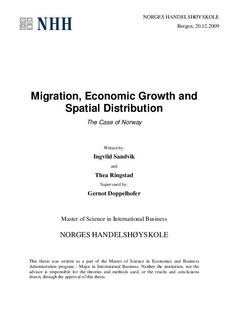| dc.description.abstract | Norway has the largest share of immigration applicants compared to the other Nordic
countries. With the addition of the EU-8 in the last round of member admissions in the EU
and EEA, the distribution of immigrants from the Eastern European countries has been
booming. Therefore, we wanted to examine the effect of this migration on growth.
Additionally, according to the World Development Report 2009, there are ever increasing
differences between rural and urban areas. We have decomposed some of the reasons for this
skewed distribution of income on the regional level, and assessed whether migration may be
a significant contributor to these differences. Thus, we wanted to find an answer to the
following research question:
How do in-migrants with different skill diversities contribute to the spatial distribution in
Norway, and which migration policies should be applied for the enhancement of further
productivity growth?
To be able to answer these questions we looked into the economic theory of migration and
growth models, and also conducted an empirical analysis, where the goal is to gain
knowledge on Norway’s dependency on labor migrants. We include the theoretical
framework, where we present models on the effect neoclassical growth models and new
economic geography with respect to migration. In our regression analysis we looked at
variables for income, technology, education and a structural variable to determine the growth
in neoclassical terms. In regards to the new economic geography we added variables that
incorporate the effects of agglomeration forces. In respect to migration, we used different
instruments to disentangle the simultaneity between migration and economic growth.
We found that the migration has no significant effect on economic growth. In terms of
regional convergence, we can see that the poorer regions have been catching up, but at a
rather slow speed. And, despite this catching up, we see that the disparity in urban and rural
areas continue to grow in Norway due to agglomeration effects. Our empirical analysis gives
support to the relevance of new economic geography theory. | en |
